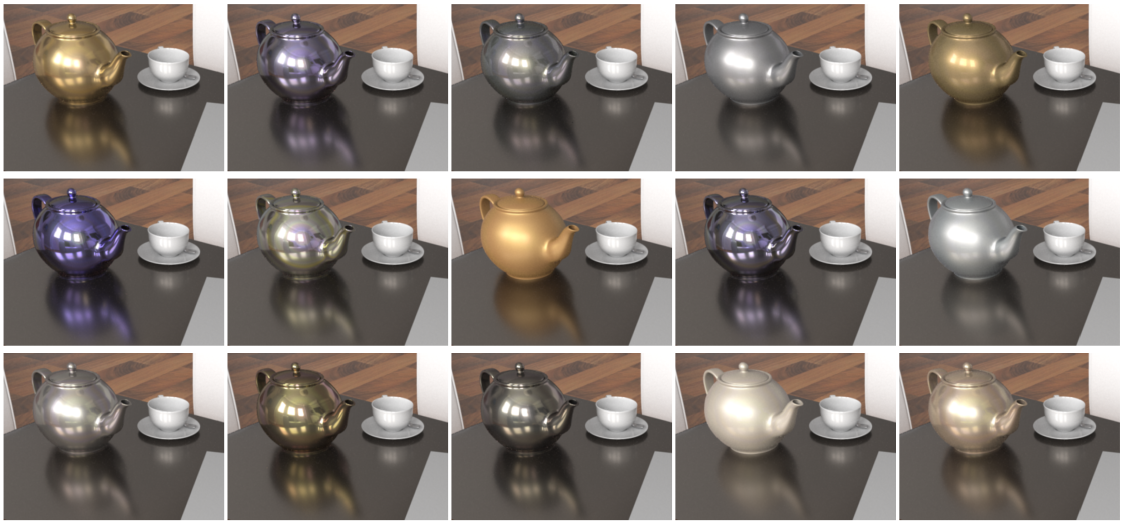Section: New Results
Illumination simulation and materials
Rendering homogeneous participating media
Participants : Beibei Wang, Nicolas Holzschuch, Liangsheng Ge, Lu Wang.
Illumination effects in translucent materials are a combination of several physical phenomena: refraction at the surface, absorption and scattering inside the material. Because refraction can focus light deep inside the material, where it will be scattered, practical illumination simulation inside translucent materials is difficult. We have worked on a Point-Based Global Illumination method for light transport on homogeneous translucent materials with refractive boundaries. We start by placing light samples inside the translucent material and organizing them into a spatial hierarchy. At rendering, we gather light from these samples for each camera ray. We compute separately the sample contributions for single, double and multiple scattering, and add them. Multiple scattering effects are precomputed and stores in a table, accessed at runtime. An illustration of our approach is given in Fig 5. We present two implementations of our algorithm: an offline version for high-quality rendering and an interactive GPU implementation. The offline version provides significant speed-ups and reduced memory footprints compared to state-of-the-art algorithms, with no visible impact on quality. The GPU version yields interactive frame rates: 30 fps when moving the viewpoint, 25 fps when editing the light position or the material parameters. This work was published in IEEE Transactions on Visualization and Computer Graphics [9].
|
Storing the precomputed table for these multiple scattering effects is the largest memory cost for this algorithm. In a separate work, we used a neural network to encode these effects. We replaced the precomputed multiple scattering table with a trained neural network, with a cost of 6490 bytes (1623 floats). At runtime, the neural network is used to generate multiple scattering. The approach can be combined with many rendering algorithms, as illustrated in Fig. 6. This work was published as a Siggraph Talk [12].
|
Fast global illumination with discrete stochastic microfacets using a filterable model
Participants : Beibei Wang, Lu Wang, Nicolas Holzschuch.
Many real-life materials have a sparkling appearance, whether by design or by nature. Examples include metallic paints, sparkling varnish but also snow. These sparkles correspond to small, isolated, shiny particles reflecting light in a specific direction, on the surface or embedded inside the material. The particles responsible for these sparkles are usually small and discontinuous. These characteristics make it difficult to integrate them efficiently in a standard rendering pipeline, especially for indirect illumination. Existing approaches use a 4-dimensional hierarchy, searching for light-reflecting particles simultaneously in space and direction. The approach is accurate, but still expensive. We have shown that this 4-dimensional search can be approximated using separate 2-dimensional steps. This approximation allows fast integration of glint contributions for large footprints, reducing the extra cost associated with glints be an order of magnitude, as illustrated in Fig. 7. This work was published in Computer Graphics Forum and presented at the Pacific Graphics conference [10].
|
Handling fluorescence in a uni-directional spectral path tracer
Participants: Michal Mojzík, Alban Fichet, Alexander Wilkie
We present two separate improvements to the handling of fluorescence effects in modern uni-directional spectral rendering systems.
The first is the formulation of a new distance tracking scheme for fluorescent volume materials which exhibit a pronounced wavelength asymmetry. Such volumetric materials are an important and not uncommon corner case of wavelength-shifting media behaviour, and have not been addressed so far in rendering literature. This new tracking scheme (figure 8(b)) converges faster than a simple modification that can be added to the traditional exponential tracking (figure 8(a)).
The second one is that we introduce an extension of Hero wavelength sampling which can handle fluorescence events, both on surfaces, and in volumes. Both improvements are useful by themselves, and can be used separately: when used together, they enable the robust inclusion of arbitrary fluorescence effects in modern uni-directional spectral MIS path tracers (figure 8(c)). Our extension of Hero wavelength sampling is generally useful, while our proposed technique for distance tracking in strongly asymmetric media is admittedly not very efficient. However, it makes the most of a rather difficult situation, and at least allows the inclusion of such media in uni-directional path tracers, albeit at comparatively high cost. Which is still an improvement since up to now, their inclusion was not really possible at all, due to the inability of conventional tracking schemes to generate sampling points in such volume materials. This work was published in the journal Computer Graphics Forum [6].
A versatile parameterization for measured material manifolds
Participants: Cyril Soler, Kartic Subr, Derek Nowrouzezahrai.
A popular approach for computing photorealistic images of virtual objects requires applying reflectance profiles measured from real surfaces, introducing several challenges: the memory needed to faithfully capture realistic material reflectance is large, the choice of materials is limited to the set of measurements, and image synthesis using the measured data is costly. Typically, this data is either compressed by projecting it onto a subset of its linear principal components or by applying non-linear methods. The former requires many components to faithfully represent the input reflectance, whereas the latter necessitates costly extrapolation algorithms. We learn an underlying, low-dimensional non-linear reflectance manifold amenable to rapid exploration and rendering of real-world materials. We can express interpolated materials as linear combinations of the measured data, despite them lying on an inherently non-linear manifold. This allows us to efficiently interpolate and extrapolate measured BRDFs, and to render directly from the manifold representation. We exploit properties of Gaussian process latent variable models and use our representation for high-performance and offline rendering with interpolated real-world materials. This work has been published in the journal Computer Graphics Forum [7], and presented at Eurographics 2018.
|








